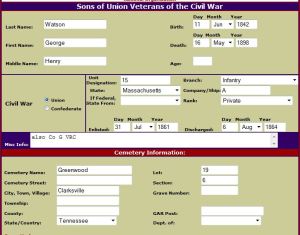NEW Civil War Union Grave Site Database
March 26, 2012 at 3:44 am | Posted in American Civil War Genealogy Resources, Genealogy Websites | Leave a commentTags: civil war cemetery finding aide
While at a National Archives workshop on Civil War records recently, I learned of an amazing new project that will help Civil War genealogists find their ancestors’ resting places easier than ever.
After the presentation a gentleman in the audience stood up and identified himself as a member of the Sons of the Union Veterans of the Civil War. Further, he shared that as part of the sesquetennial
(150th Anniversary) celebration of the Civil War the organization has set out to identify and record the burial site of every one of the Civil War veterans. Wow. They are spending their weekends walking cemeteries nationwide to find our fallen heroes resting places.
But wait! It gets better. Then they are recording those findings in their online database for everyone to use – for FREE. You just gotta love these guys.
Now, not to be partial to only one side, the gentlemen said with great authority that the Confederate Veterans organization is working toward the same goal for their fallen heroes. Both organizations plan to finish their projects by the end of the anniversary period in 2015. He estimated that they are at about 15% completion right now. Continue Reading NEW Civil War Union Grave Site Database…
Civil War Unit Histories | Genealogy Resource
October 10, 2011 at 3:12 am | Posted in American Civil War Genealogy Resources, Genealogy Resources | Leave a commentTags: american civil war research, civil war class, civil war resource, civil war unit history reference, civil war unit history research, genealogy class, genealogy research, genealogy resource
Civil War Unit Histories can be a genealogist’s best friend. Why? Because they offer the history and context of your ancestor’s experiences. You know he didn’t go to battle alone. His experiences were shared with is unit, so their history is his history.
What can a unit history tell about your ancestor? Lots. Here are just a few examples:
- The nativity, character and make up of his unit. Where were the guys from, what did they do, why did they muster in?
- What’s the story of their enlistment and training? What was camp like?
- Granular detail on all of the battles waged by that unit. You care about this because you can abutt the timeline of the unit against what you know about your ancestor and determine which battles he participated in. For those in which he was absent you can chase down the reason – AWOL, capture, injury, not yet enlisted.
- Muster rolls or unit enumerations. If you think your ancestor served in the area in which this unit mustered, this may be your ticket to finding him.
- Personal stories – the unit is made up of the aggregate of all of the soldiers. Maybe your ancestor – especially if he was an officer – was mentioned in the stories of the battles. Was he captured? Was he wounded? Did he die? It’s not impossible to imagine him getting a mention.
So, with this goldmine of information awaiting us, you can only imagine my delight at finding the unit history motherload. This tremendous anthology of unit histories – Union AND Confederate – is a must for anyone searching.
Here’s what you need to know to find this:
Title: Civil War Unit Histories | Regimental Histories and Personal Narratives
Publisher: University Publications of America
Format: Index in hard print copy, Anthology on microfilm.
Inside scoop: This is how to use the archive. Start with the indexes. There are several printed indexes. Each index is divided by alliegience and geographic area. Within the index you search first by alliegience (Union/Confederate), then by state. My Civil War ancestor served in the Union for Massachusettes. So, I went to the index on the Union, then the state of Massachusettes. From there the index is divided by unit specialty (artiliary, infantry, etc.). My ancestor served in the Infantry, so I scoped into that section. Finally, the Infantry section is divided by Regimental Unit name or number. (Remember, some units especially in the South were named for their comanding officers, which can make this a tad challenging.)
Now that you’ve drilled down to the unit of interest, you have – hopefully – several resources to research. Each separate book/story/personal history is itemized and numbered with the numaric prefix starting with the state initials, i.e. MA for Massachusettes. Just like a book description in a library catalog, there will be a fairly detailed description of the different sources. In my case I found a 422 page history on the unit (wow!), and a 17-page ulogy on a soldier who died at Gettysburg. Wouldn’t you bet that would have great personal interest not just to the descendents, but anyone he served with?
You’re almost there – the land of unit history milk & honey! The final step is to look up the unit history by it’s indexed number in the microfilm archive accompanying the paper index. Rinse & repeat with all of the sources you’ve found!
Bonus tip: Not up for a day of reading microfilm? Try this: type in the full title of the book or narrative you just found in the index in this free website: books.google.com. If you’re lucky Google has digitized the item (out of print; out of copywrite books), and put it online for you to read or download – FOR FREE!
Don’t overlook unit histories in your military research. It’s a treasuretrove of material.
Want a primer on Civil War Genealogy? Check out my online class.
Blog at WordPress.com.
Entries and comments feeds.
